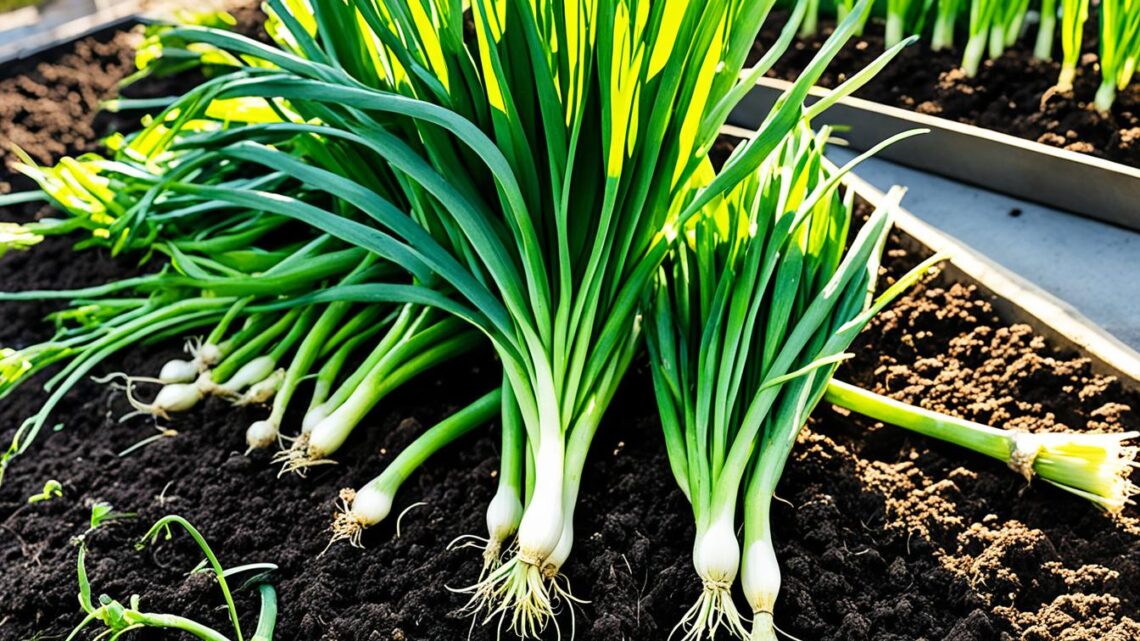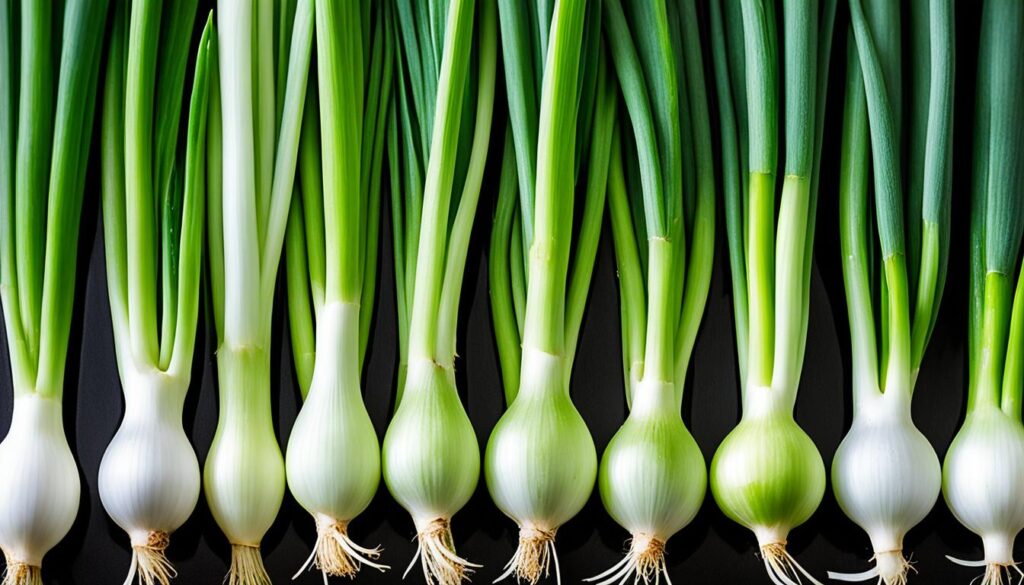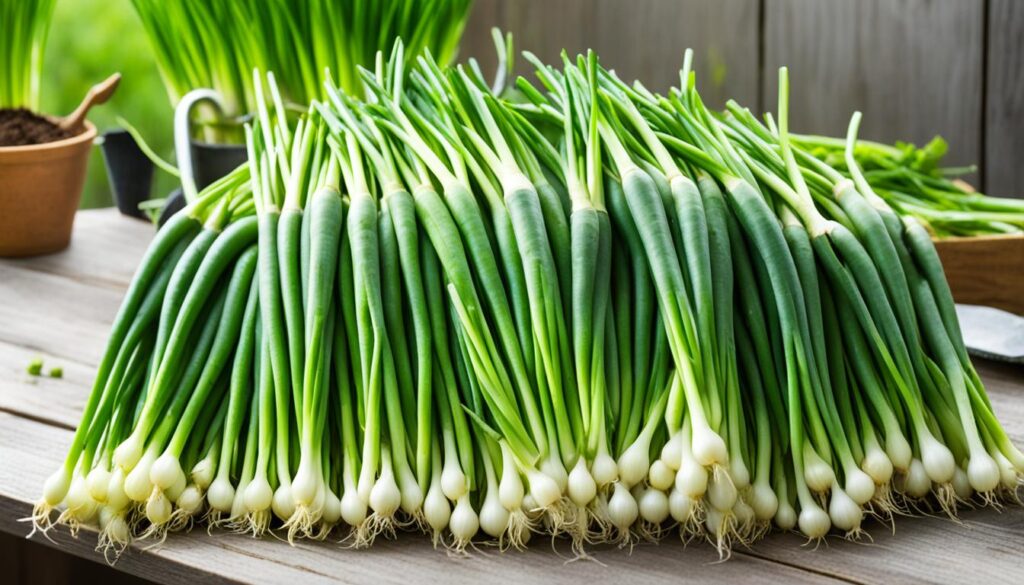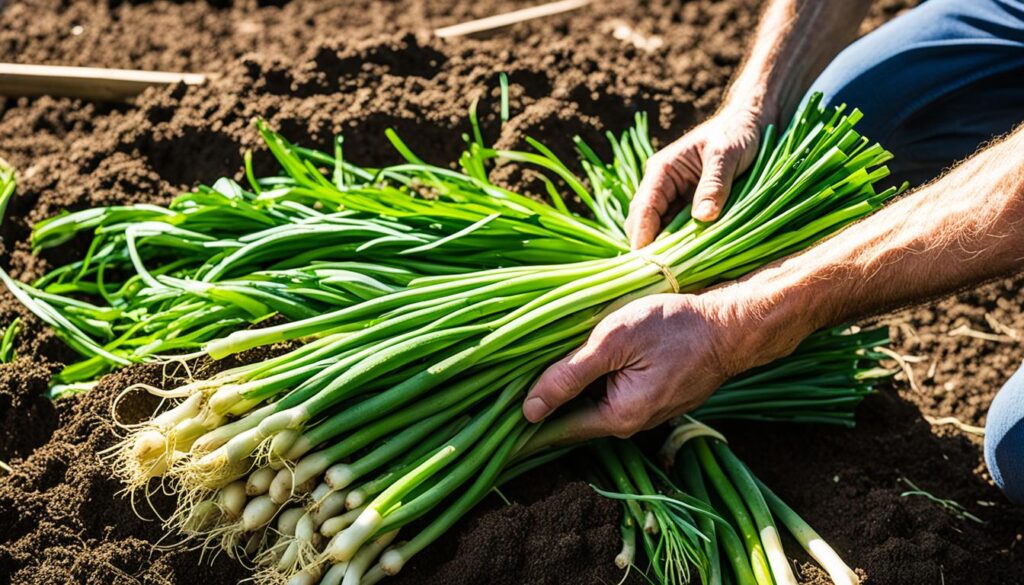
Are you ready to learn how to grow your own spring onions? These versatile alliums can make your cooking better and help your garden grow. They’re great for savory stir-fries and fresh salads. Spring onions, also called scallions or green onions, are essential in any kitchen. With a few simple steps, you can have them for months.
This guide will take you through the world of spring onions. We’ll look at their types, flavors, and how to plant, grow, and harvest them. Whether you’re experienced or new to gardening, you’ll find tips to grow a great spring onion crop. This will keep your kitchen full of fresh, tasty ingredients for all your recipes.
What are Spring Onions?
Spring onions, also known as scallions or green onions, are part of the Allium family. They are young onions with edible green stems and small bulbs. You can find them in white, red, and bunching types, all good for cooking.
Varieties and Terminology
«Scallions,» «green onions,» and «spring onions» are often mixed up, but they’re not exactly the same. Scallions have a thin white bulb. Green onions have a bit thicker white part. Spring onions are the oldest, with a medium-sized bulb at the base.
Flavor Profiles and Uses
Spring onions taste milder and sweeter than big onions. You can eat the whole plant, from the base to the green top. Use them raw in salads, cooked in stir-fries, or in soups for a bit of onion flavor and crunch.
They’re loved in many cuisines around the world. Spring onions are packed with vitamins, minerals, and antioxidants.
| Allium Variety | Bulb Size | Flavor Profile | Culinary Uses |
|---|---|---|---|
| Scallions | Slim | Milder, more pungent | Salads, stir-fries, garnishes |
| Green Onions | Slightly wider | Milder, more delicate | Soups, stews, sauces |
| Spring Onions | Small to medium | Sweeter, more mature | Roasted, grilled, sautéed |

Planting and Growing Spring Onions
Growing spring onions is easy and fun. Think about the climate, taste, and how they grow when picking a type. They do well in soil that drains well and has lots of nutrients. You can plant them directly in the ground or start them inside and move them outside later.
Choosing the Right Variety
There are many spring onion varieties to choose from, each with its own special traits. ‘White Lisbon’ grows fast, ‘Lilia’ has a red bulb, ‘Performer’ tastes mild, and ‘North Holland Blood Red’ is great for salads or as a bulb onion.
Soil Preparation and Sowing
Getting the soil ready is key for spring onions. They like soil that drains well and is full of humus, with a pH of 6-7. Before planting, add compost or fertilizer to the soil. You can plant the seeds directly or start them inside and move them outside later.
Care and Maintenance
Looking after spring onions means watering them regularly and using a liquid fertilizer or compost tea when they’re growing. Keep an eye out for weeds and pests to make sure you get a big harvest.

With the best spring onion varieties, soil, and care, you can have a steady supply of tasty spring onions all year.
Harvesting and Storing Spring Onions
When to Harvest
Spring onions are ready to pick in 8-12 weeks after planting. Look for leaves that are tall, green, and healthy. For bulb types, wait for the leaves to flop over, showing the bulbs are ready.
Proper Harvesting Techniques
To pick spring onions, use a small fork or your hands. Loosen the soil around the plants and pull them up by the base. If you just need a few leaves, cut them off at the soil line. This lets the roots grow back.
Spring onions don’t keep well in the fridge. Use them right after picking. They can stay in the fridge for a few days. Keep them in a damp paper towel or plastic bag.
| Storage Method | Shelf Life |
|---|---|
| Stored in a jar of water in the fridge | 2-3 weeks |
| Wrapped in a paper towel and placed in a bag in the fridge | 2 weeks |
| Stored loose in the crisper drawer of the refrigerator | 1-2 days |
| Stored like a bouquet of flowers on the counter | 3-4 days (possibly up to a week) |
Spring onions need humidity to stay fresh. Keep them moist when storing. You can freeze them for up to 6 months, but the taste might not be as good.

Using Spring Onions in the Kitchen
Spring onions add a special touch to many dishes, both savory and sweet. They bring a delicate crunch to salads and a subtle sweetness when cooked. These alliums are essential in any kitchen.
Spring onions are great raw in salads and sandwiches. They mix well with leafy greens, tomatoes, and other crisp veggies. Try them on hummus toast for a burst of flavor and color.
Cooked spring onions are sweeter and milder than raw ones. They’re perfect in stir-fries, omelets, and with grilled or roasted veggies. Pair them with asparagus for a bright, lemony side dish.
Spring onions can also tenderize meat or fish in marinades. They cook fast, saving you time in the kitchen.
Jamie Oliver uses spring onions in his dairy-free hollandaise sauce and for a quick steak dinner. Next time you see them at the market, grab some and try them in your cooking.
| Dish | Ingredients | Prep Time | Servings |
|---|---|---|---|
| Grilled Asparagus and Spring Onions with Lemon Dressing | Asparagus, spring onions, olive oil, lemon juice, salt, pepper | 15 minutes | 4-6 |
| Butter-Braised Spring Onions with Lots of Chives | Spring onions, butter, chives, salt, pepper | 20 minutes | 4 |
| Spring Onion Soup | Spring onions, peas, olive oil, butter, salt, pepper | 15 minutes | 4-6 |
Pests and Diseases
Spring onions are easy to grow but can face pests and diseases. Knowing about these issues helps you protect your spring onion crop.
Common Problems
Some common problems with spring onions are:
- Onion fly – These pests can burrow into the bulbs, causing them to rot and decay.
- Thrips – These tiny insects feed on the leaves, causing them to become discolored and stunted.
- Fungal diseases like downy mildew – These can cause the leaves to yellow and die back, ultimately affecting the overall health of the plant.
Preventive Measures
To reduce pests and diseases, follow these steps:
- Keep your garden clean by removing infected or damaged plants.
- Give your spring onions the right growing conditions, like well-drained soil and enough water.
- Plant herbs like mint with your spring onions to keep onion fly away.
- Use organic pest control, like beneficial insects or neem oil, to fight pests.
- Rotate your crops to stop fungal diseases from spreading.
By being careful and taking these steps, you can grow healthy and plenty of spring onions.
Companion Planting with Spring Onions
Spring onions are great for the garden. They keep pests like aphids and rabbits away. These plants can be grown with many vegetables and flowers. This makes your garden healthy and full of life.
Spring onions and carrots are a perfect pair. The onions keep carrot flies away, and carrots help protect onions. They also keep worms and weevils away from the cabbage family.
- Onions and carrots grow well together, using different parts of the soil.
- Onions near tomatoes, peppers, and cucumbers keep away aphids and beetles.
- Herbs like parsley, mint, and chamomile help keep onion flies away and taste better.
| Companion Plant | Benefits |
|---|---|
| Carrots | Deter carrot flies, while onions deter onion flies |
| Cabbage family | Provides resistance to pests like worms and weevils |
| Tomatoes, Peppers, Cucumbers | Deter aphids, Japanese beetles, and other common pests |
| Parsley, Mint, Chamomile | Ward off onion flies and enhance onion flavor |
Adding spring onions to your garden helps keep pests away. It makes your plants healthier and more productive. Try different plants with spring onions to make the most of your garden.
Spring Onions: A Versatile and Easy-to-Grow Crop
Spring onions are perfect for both new and seasoned gardeners. They grow fast, need little space, and give lots of food. These alliums are great for any garden that wants to grow food.
They are easy to grow because they can handle many soils and climates. They just need good soil, water, and some food now and then. Even if you’re new to gardening, you can grow spring onions in beds, pots, or on a windowsill.
Spring onions are also very useful in the kitchen. You can use the whole plant in many dishes. They add flavor to salads, stir-fries, soups, and marinades. With spring onions, you can try new recipes and always have fresh ingredients.



